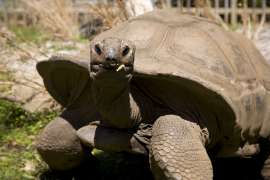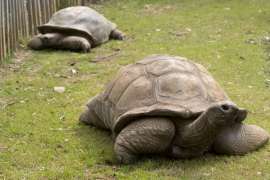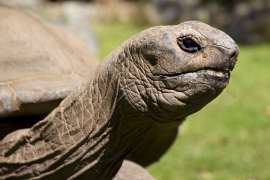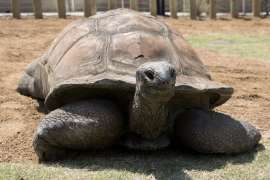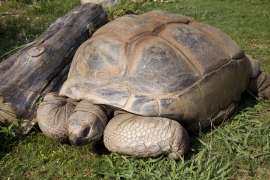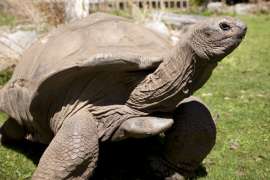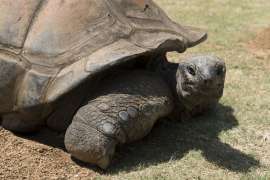Aldabra Giant Tortoise
Aldabra Giant Tortoise
Aldabra tortoises are the second-largest species of tortoise in the world and, like their larger relatives on the Galapagos Islands, this species is also restricted to a few islands north of Madagascar.
Aldabrachelys gigantea
Herbivore
Eastern Africa [VIEW MAP]
Grasslands, Scrublands
During the warmer months, these giants are easy to observe in their large open space at Scaly Slimy Spectacular: The Amphibian and Reptile Experience, often resting for hours in their pond or self-made mud wallow with their heads under water. In the cooler months, they are moved to their specially-designed greenhouse near Outback Station. Aldabra tortoise Wild Encounters offer guests a chance to meet and feed the tortoises.
Photos and Videos
Originally, there were six species on the various islands of the Aldabra Atoll. All but one (the species found on Aldabra) were thought to be extinct until recent research. Based on morphological (body shape measurements) data, three species were deemed to still exist. Zoo Atlanta’s Aldabra tortoises have been trained to follow a target to facilitate moving them. This training helps to facilitate shifting the tortoises into their indoor habitat, particularly in the colder months.
Aldabra tortoises are sexually dimorphic, meaning that there are differences in appearance between males and females. The tails of the males are thicker and longer than the tails of the females. The males’ carapaces are broader and flatter relative to the females’ domed carapaces. Males also grow larger than females. The males weigh about 300 pounds, and the females weigh about 200 pounds. The maximum weight of the Aldabra tortoise is 600 pounds.
These tortoises may easily exceed 100 years of age; however, documenting the true age of an individual is difficult as complete records from previous centuries typically do not exist. The tortoises at Zoo Atlanta arrived as young adults in the middle 1960s, so they may be more than 80 years of age. Reproduction in this species is similar to that of most terrestrial turtles. The male will mount the female, often while producing loud wheezing vocalizations, and the female will eventually dig a nest, and deposit eggs to hatch a few months later. There is no parental care.
During the warmer months, these giants are easy to observe in their large open space at Scaly Slimy Spectacular: The Amphibian and Reptile Experience, often resting for hours in their pond or self-made mud wallow with their heads under water. In the cooler months, they are moved to their specially-designed greenhouse near Outback Station. Aldabra tortoise Wild Encounters offer guests a chance to meet and feed the tortoises.
The only natural populations are on Aldabra Atoll. There are different species on different islands. They have been introduced to other islands in the Seychelles.
These tortoises tend to live in relatively dry forests and scrublands.
In the wild, these tortoises eat a variety of grasses, leaves and plants. At Zoo Atlanta, they receive hay, collard greens, romaine, small amounts of assorted vegetables and fruit, and a commercially-prepared tortoise diet.

